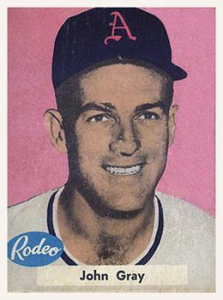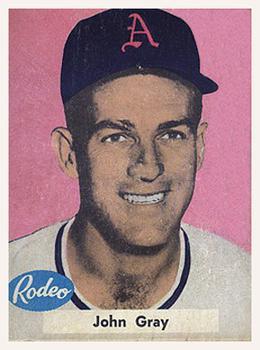July 30, 1957: In first game with Cleveland, Johnny Gray tosses 3-hit shutout against Baltimore

Johnny Gray, a 6-foot-4, 220-pound right-hander, pitched without much success for four major-league teams between 1954 and 1958. His finest hour came July 30, 1957;1 in his first game with the Cleveland Indians and his first major-league appearance in nearly two years, Gray blanked the Baltimore Orioles on three hits, winning 6-0.
Gray had joined Cleveland three days earlier from San Diego of the Pacific Coast League to “bolster a collapsing Indians pitching staff.”2 He had been one of the Indians’ final cuts of spring training, holding a roster spot when Cleveland broke camp in Tucson, only to be demoted on April 10, the day after he walked seven New York Giants in an exhibition loss as the Indians made their way home to Cleveland.3
Gray, who had briefly pitched for San Diego in 1955, and pitched for various Triple-A teams between 1952 and 1956, balked at returning to the PCL. Hank Greenberg, the Indians’ general manager, gave him permission to engineer his own trade, but only with a National League club.4
Of course, Gray’s task was almost sure to fail: Greenberg could veto any deal Gray proposed because the reserve clause bound him to Cleveland, and in an era when player agents were uncommon—especially for marginal players like Gray—he was on his own during negotiations. Gray unsuccessfully tried to catch on with a NL team, then reluctantly reported to San Diego, where he went 4-3 with a 1.85 ERA through July.
At that point, Gray’s stay in San Diego paid off. Thanks to his performance, the 30-year-old Gray was back with the Indians, wearing uniform number 6 and set to face the Baltimore Orioles in Baltimore’s Memorial Stadium. His mound opponent was Billy Loes (10-5), a right-hander who pitched for three pennant-winning Brooklyn Dodgers teams, and beat the New York Yankees in Game Four of the 1953 World Series.
Baltimore had spent $20,000 to obtain Loes from Brooklyn in May 1956. It looked like a bad investment when the sore-armed Loes stumbled to a 2-7 record in 56⅔ innings as a reliever. But in 1957, with a healthier arm, Loes had turned things around as part of Baltimore’s starting rotation.
Between May 19 and June 30, Loes pocketed seven wins without a loss, and on July 9 he tossed three scoreless innings in the All-Star Game at St. Louis. With Loes on the mound, the pitching matchup clearly favored Baltimore.
Loes took care of Cleveland’s leadoff hitter, rookie Larry Raines, then yielded consecutive singles to Al Smith, Gene Woodling, and Vic Wertz, sending Smith across home plate. A double play, one of three turned by the Orioles, ended the inning without further damage, and Loes did not allow another runner past second base until the ninth.
Gray, meanwhile, breezed along, allowing just three baserunners through eight innings. In the second, Gus Triandos singled when his sinking liner to left field landed just beyond the reach of a diving Woodling. Gray walked Bob Boyd in the fourth and Jim Busby in the fifth. No Baltimore baserunner advanced beyond first base; entering the ninth, Loes and Gray were locked in a classic 1-0 pitchers’ duel.
Loes snuck a called third strike past Al Smith to begin the ninth before Cleveland erupted. Woodling doubled to left for his third hit; 22-year-old rookie Roger Maris ran for him. Wertz drove in Maris with a single; collecting his third hit and second run batted in of the night. (Wertz’s 72 RBIs trailed only Mickey Mantle’s 73 in the AL.)
Joe Altobelli ran for Wertz, and when Orioles shortstop Jim Brideweser bobbled Rocky Colavito’s grounder, the Indians had runners at first and second. Bobby Avila singled Altobelli home, and when center fielder Busby’s throw to the plate sailed far over the catcher’s head, Colavito raced to third and Avila to second. That was the end of the line for Loes; George Zuverink replaced him with two runners in scoring position and Baltimore trailing, 3-0.
Zuverink intentionally walked Russ Nixon, loading the bases, and setting up a possible force out or double play. Baltimore’s strategy failed when Chico Carrasquel shot a single off third baseman George Kell’s glove to score Colavito and Avila and advance Nixon to second.
Leading 5-0 and hoping for more, Gray sacrificed Nixon and Carrasquel into scoring position. With two out, Brideweser botched Raines’ grounder—Brideweser’s second error of the inning—allowing Nixon to trot in from third with Cleveland’s sixth and final run. The Indians’ offense, combined with Baltimore’s erratic defense, had blown the game open.
In the bottom of the ninth, Gray returned to the mound ahead, 6-0, needing three outs for his first big-league shutout and his first major-league win since September 4, 1954, when as a rookie with the Philadelphia Athletics, he had hurled a complete-game six-hitter to top the Boston Red Sox.
Second baseman Avila caught Billy Gardner’s short fly, giving Gray, who appeared to be cruising, a string of 12 straight outs. But two outs away from defeat, the Orioles showed signs of life.
Boyd—who would finish fourth in the AL batting race at .318—singled,5 and Kell beat out a bunt, putting runners at first and second with just one out. Left-handed Don Mossi warmed in the bullpen in case he was needed, but Bob Nieman flied to left, and Triandos lofted a popup caught by shortstop Carrasquel for the final out.
It was a great night for Gray; he earned the fourth win of his career and threw his first shutout, limiting Baltimore to three singles, and two walks. He shut down the Orioles “with a hard slider, changes in speed, a big motion and good control.”6
Gray was not often complimented on good control. Lack of control had been a recurring weakness. In his only extended stay in the major leagues—the second half of 1954, as a regular in the Athletics’ pitching rotation during the franchise’s final season in Philadelphia—Gray walked 91 in 105 innings and went 3-12 with a 6.51 ERA.
Gray remained with the franchise when it relocated to Kansas City in 1955, and he still had trouble throwing strikes. In May, dogged by a 10.64 ERA, Gray was optioned to the International League, only to rejoin Kansas City in August. In total, he made five starts and three relief appearances, finishing 0-3 with a 6.41 ERA and 24 walks in 26⅔ innings.
Fresh off his shutout of Baltimore, Gray started on August 4 in Yankee Stadium opposite Whitey Ford. Gray—who spent 1950-53 in the New York Yankees farm system—ran his scoreless-inning streak to 11⅓ before the pennant-bound Yankees scored. Aided by Cleveland’s porous defense, New York added four more runs in the fourth. In his four-inning stint, Gray surrendered six hits, three walks, and five runs (although only one run was earned), and he suffered the loss, dropping his record to 1-1.
Gray made what turned out to be his final major-league start on August 7 in Detroit, lasting only one-third of an inning and taking the loss. Gray faced six batters; three got hits and two drew walks. On August 10 against Kansas City, Gray lost in relief—his third loss in seven days.
On December 2, 1957, the Philadelphia Phillies selected Gray in the Rule 5 draft. Phillies manager Mayo Smith knew Gray, since both men lived in Lake Worth, Florida, and Smith had managed Gray in the low minors.7 The Phillies thought Gray could be an effective middle-inning reliever.8
With the Phillies in 1958 Gray relieved in 15 games without recording a decision. Control was still a problem: in 17⅓ innings he walked 14. Gray last pitched on July 16 before being shipped to Miami of the International League.
Gray never again pitched in the majors, and he was out of baseball after the 1960 season. His 4-18 record, 6.18 ERA, 7.6 walks per nine innings, and 1.858 WHIP cast doubt on his qualifications as a major-league pitcher, but for one night in Baltimore, Gray proved he belonged.
Acknowledgments
This article was fact-checked by Kevin Larkin and copy-edited by Len Levin.
Sources
In addition to the sources cited in the Notes, the author consulted Baseball-Reference.com and Retrosheet.org for pertinent information, including the box score and play-by-play. The author also relied on game coverage in the Akron Beacon Journal and Baltimore Sun, and reviewed SABR BioProject biographies for several people participating in the game.
https://www.retrosheet.org/boxesetc/1957/B07300BAL1957.htm
https://www.baseball-reference.com/boxes/BAL/BAL195707300.shtml
Notes
1 Gray’s Game Score of 80 was by far his highest.
2 Jim Schlemmer, “Tribe Hopes Caffie Has That ‘Gray,’” Akron Beacon Journal, July 31, 1957: 26.
3 Schlemmer.
4 Schlemmer.
5 Boyd became the modern Orioles’ first .300 hitter.
6 Bob Maisel, “5-Run Ninth Ends Duel with Loes,” Baltimore Sun, July 31, 1957: 15.
7 “Gray, Drafted by Phillies, Hurled for Smith in Minors,” The Sporting News, December 18, 1957: 6.
8 Allen Lewis, “Phillies Do What Comes Naturally in Getting Philley,” The Sporting News, December 25, 1957: 8.
Additional Stats
Cleveland Indians 6
Baltimore Orioles 0
Memorial Stadium
Baltimore, MD
Box Score + PBP:
Corrections? Additions?
If you can help us improve this game story, contact us.


